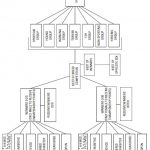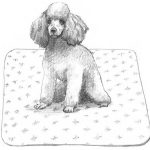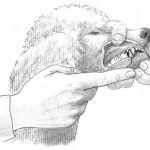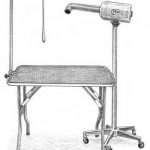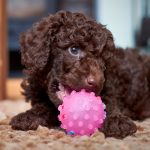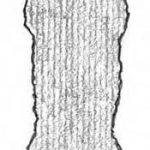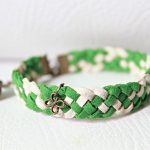In This Chapter
- Getting your Poodle used to new folks
- Dealing with new situations, objects, and noises
Faces, places, and things that go bump in the night: You want your Poodle to be comfortable with all of these things. This chapter helps you socialize your Poodle so that he’s not a “scaredy cat.”
Acclimating Your Poodle to New Faces
Your Poodle needs to feel comfortable in the world beyond his immediate family, and the only way that’s going to happen is to introduce him to as many different people as possible while he’s young. (You can socialize an older dog, but it’s much harder.) I give you some pointers in the following sections.
Meeting the neighbors
Give your Poodle a few days to get used to his new home and family (see Chapter
Preparing for Your Poodle’s Homecoming about welcoming your Poodle home) and then start introducing him to the wide world. Until he has all his shots, you don’t want him running at the local dog park, but he can start to meet the neighbors — both human and canine.
Let your children bring home their friends to play with your Poodle. Supervise their play so no one gets hurt. Make sure younger children, especially, understand how to be gentle with a puppy, and keep the play sessions short and quiet. Very young children don’t understand that tugging on an ear or a tail can hurt a dog, so you may have to remove either the puppy or the child from the group. Chapter
Preparing for Your Poodle’s Homecoming has more details on introducing a Poodle to children.
Remember
To a dog, all humans aren’t created equal. A dog differentiates between men, women, and children and needs to meet and be comfortable with all three categories:
– If you’re childless, ask the neighbor children to play with your puppy.
– If you have no men in your household, ask a few male friends to stop by to meet your puppy.
– If your household is all male, find a female or two who can help socialize your puppy.
Many experienced dog trainers recommend that a puppy meet at least 100 people by the time he’s 12 weeks old. Here are some guidelines for introducing your Poodle to new people:
– If you have a fenced yard, invite friends and neighbors over to meet your Poodle while he’s off his lead. If you don’t have a fence, keep your Poodle on a lead for the meetings. Have plenty of treats handy for the visitors to give.
– If your Poodle is full of energy and likely to jump up, be cautious around small children, who can get knocked down. Keep your dog on a lead when meeting children, and encourage children to approach him quietly.
– Carry treats with you on walks. If you meet someone, ask if they’ll pet your Poodle and give him a treat.
Anecdote
My adult female is a bit shy, but she never hesitates to approach a stranger at a dog show because she’s learned that almost everyone has a pocketful of liver!
– Keep greetings low key, and let your Poodle approach people on his own. Don’t drag him up to people and force him to hold still for petting.
Setting up play dates
Play dates are a good way for your puppy to meet other dogs in a controlled setting. If you know someone with a puppy of any breed, or with a smaller adult dog, arrange a play date. Plan the date for a secure area. At first, it’s best to have two or three dogs in the group so it’ll be easier to control them should things get out of hand.
Warning!
While your Poodle is still a puppy, stay away from larger adult dogs who may be too rough for a puppy. If your dog’s play date is with an adult dog, make the introductions gradually. Most adult dogs are fine with a small puppy, but it’s better to be safe than sorry. Keep the dogs on loose leads for the introduction.
Tip
Don’t tighten the leads. The tension of the lead can translate as tension, which can lead to aggression, instead of a friendly greeting.
Most adult dogs understand that puppies aren’t a threat, and they’ll accept things from puppies that they would never allow in another adult dog. Still, if you notice the hair on the adult dog’s neck and back going up or feel a growl through the lead, or if the adult lifts his lip, it’s time to separate the dogs before a fight breaks out.
You can organize neighbors to meet an older Poodle, too, but you may need to be more cautious. An older dog may already be leery of children or men, and you need to proceed slowly and with care to overcome your dog’s fear.
Enrolling in puppy kindergarten or other classes
If you don’t have any children in your neighborhood and can’t find a friend with a dog for play dates, puppy kindergarten is a wonderful way to socialize a puppy. Animal shelters sometimes hold puppy kindergarten classes, or they may know someone who does offer classes. Call area boarding kennels or contact your local kennel club or dog training club to find a puppy kindergarten near you.
Although your puppy may discover a few basic commands in class, formal training isn’t the point of puppy kindergarten. The goal is to socialize the puppies and make them happy to see people and other dogs. One common kindergarten exercise is to have people sit on the ground in a circle, with a puppy in the middle. Taking turns, the people call the puppy, using a high, happy voice and giving lots of treats and pats when the puppy responds. This exercise teaches a puppy that people have good things to offer. The puppy also realizes that responding when called is a good thing.
If you’ve adopted an older dog, ask around about basic obedience classes. A beginner’s class may be the perfect way to introduce your older Poodle to strange people and dogs.
Remember
Visit any training class before joining. Look for a class that uses positive training methods. Poodles don’t respond well to harsh training methods.
Talk to the instructor ahead of time if your dog is shy or fearful around other dogs or if you think your dog may be aggressive, either with dogs or with people. A good instructor can help with these issues without endangering anyone.
Handling Strange Situations, Objects, and Noises
Getting your Poodle used to different situations, objects, and noises doesn’t mean your dog may not be startled by something, but it does mean that he can recover quickly and return to normal — and not cower or bark. In the following sections, I explain how to prepare your Poodle for car rides, get him used to new situations and objects, and handle a fear of loud noises.
Going for car rides
Most puppies adjust easily to car rides. Occasionally, a puppy can be carsick, but he generally outgrows this, especially if you make sure that rides are a pleasant treat (make sure you don’t always end at the veterinarian’s). If your puppy gets carsick, keep rides short and carry a roll of paper towels for clean up.
Tip
If you have an older dog, and he only enters the car kicking and screaming, take it slow and be patient. Open doors on both sides of the car and coax your dog in with treats, and then let him leave by way of the opposite door. Don’t try to keep him in the car.
After he’s comfortable getting in and out of the car, shut one door. Get him in the car, give him a treat, and get out of the car. Gradually, stay in the car with him, until he’s comfortable sitting with you. Shut the door and sit awhile, offering tasty treats.
When your Poodle is happy with this arrangement, take a short drive. The important word is short — which may mean the length of your driveway and back. Gradually increase the length of the ride. Drive around the block or to a neighborhood park.
Offer treats and keep your tone of voice upbeat during a car ride. Take your Poodle with you when you do your banking. Many tellers keep dog treats at the drive-thru window. Stop by the local fast food restaurant for a snack. Sometimes they also have dog biscuits at the take-out window, or you can order a burger. . . hold everything. It won’t take your dog long to associate car rides with goodies.
Remember
Did I mention that you need to restrain your Poodle in some way while he’s in the car? You can crate your dog, or you can secure him with a special seat restraint (see Chapter Choosing the Best Poodle for Youfor more about these items). As with children, your dog should always be in the back seat. Not only is it safer for the dog, but also he can’t interfere with the driver, which makes the back seat safer for everyone.
Adjusting to unfamiliar situations and objects
Introduce your Poodle to as many unfamiliar things as possible in a controlled setting, so you can make the encounters positive and reward his positive reactions.
Tip
To help familiarize your Poodle with a variety of people, places, sounds, and situations, try these helpful tips:
– Start introducing the unfamiliar when your Poodle is young and let him be a part of family life. Put his crate or pen in the kitchen or family room where he can get used to pots and pans banging or a timer beeping. Let him hear a radio or television, and if no one else does, ring the doorbell occasionally.
– Give your Poodle different surfaces to walk on. Put down a piece of carpeting or linoleum. Lay a section of screen on the floor. Put a milk jug in his pen or out in the yard. Outside, make a small playground. Cut the bottom from a box to form a small tunnel. Give him steps to go up and down.
– Take your puppy with you whenever you can (prepare him with the information on car rides in the previous section). Most banks allow dogs, and having the tellers make a fuss over your puppy and offer treats helps him think of strangers in a positive way. Weather permitting, sit on a bench outside a shopping mall. It’s an easy way for your puppy to meet all kinds of people, dressed in all kinds of outfits, as well as being exposed to shopping carts and strollers.
– Get your Poodle used to people wearing different kinds of hats, as well as glasses. Place an open umbrella near your puppy and let him get used to it.
– When you’re adding something new to the environment, invite your puppy to sniff the object. I tell my dogs to “smell,” and when they do, I praise and, if possible, give a small treat.
– If your Poodle is already a member of the family when a new baby arrives, make introductions. Some people will bring home a garment from the hospital that the baby has worn to get the dog used to the smell before the baby ever comes home. Hold the baby and let your Poodle smell it, and then praise him. A new baby needs a lot of attention, but don’t ignore your dog. Try to make time for regular walks and play. Let the dog join you as you care for the baby. The more your Poodle is included, the easier he’ll accept the new addition to the family.
The more you can introduce to your puppy, the fewer problems you’ll have when your dog grows up. You can get an adult dog used to new situations using the same techniques you use with a puppy, but it takes longer if he hasn’t had a history of discovering new situations as a puppy.
Easing a fear of loud noises
Sometimes, in spite of all your efforts, something frightens your dog. Don’t cuddle your Poodle and tell him everything is all right. You just reinforce his behavior, and he begins to equate a loud noise with your attention.
Anecdote
The first dog I ever had was terrified of thunder and felt much more secure in the bathtub or shut in the car. (I didn’t know about crates then.) As my male has aged, he’s become more sensitive to thunder. If I notice he’s becoming nervous or if he’s pacing or whining, I distract him with a toy or a treat or try to interest him in a game.
Some dogs react to thunder; others pay no attention at all. If your dog is truly bothered by thunder, you can work to desensitize him. Get a recording, or make your own, of a thunderstorm. Play this on very low volume. If your dog doesn’t react, turn the volume up a bit. As soon as your dog reacts to the sound, distract him with a game or make him work for a treat. Just say a quick “down,” “sit,” or “come,” so that he’s rewarded for doing something. You can also try a toy that holds food or dispenses it, so that your dog can focus on getting goodies and not on the noise. With each session, try to increase the volume until your dog ignores even the loudest thunderclap. This technique can be used with other loud noises, too, such as fireworks.
Tip
If your Poodle is still bothered, try putting some cotton in his ears to muffle the sound. He may just shake his head until the cotton falls out, but it’s worth a try!
The change in air pressure can bother a dog more than the actual noise of the thunder. Try to distract your Poodle with games or toys until the storm has passed. Try a peanut-butter-filled Kong or a similar toy that dispenses treats as your Poodle rolls and bats it around.
by Susan M.Ewing








